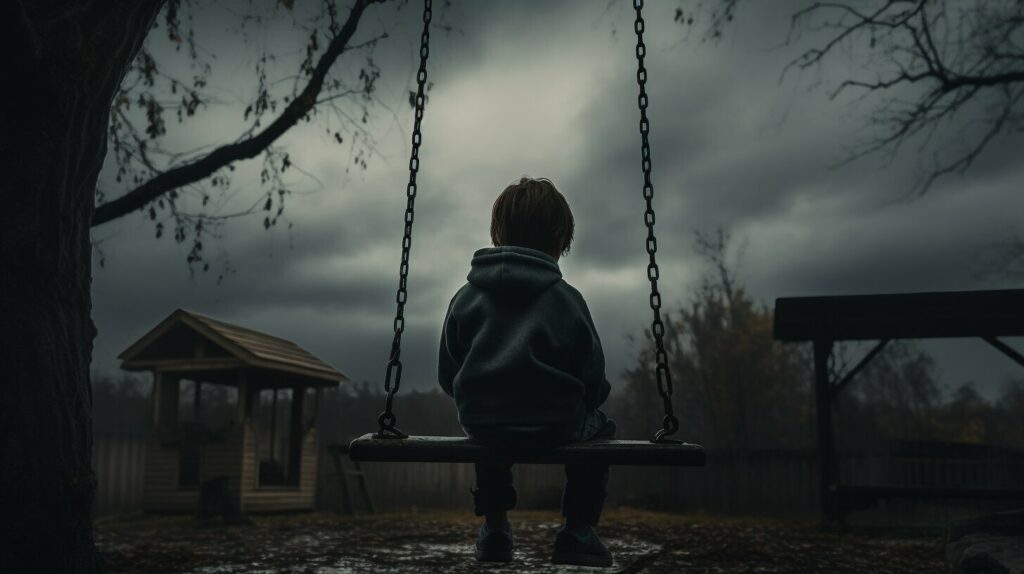As a parent or caregiver, it can be challenging to talk to your child about anxiety. You want to help them understand what they’re feeling without overwhelming or frightening them. This guide will provide you with practical tips and guidance on how to explain anxiety to a child in a friendly and supportive way.
Anxiety in children is a common concern, affecting up to 25% of kids under the age of 18. It can manifest in various ways, such as clinginess, irritability, and avoidance of social situations. As a parent or caregiver, it’s essential to approach the topic with compassion and understanding.
Key Takeaways:
- Explaining anxiety to a child can be challenging but is crucial for their mental health.
- Understanding anxiety in children is the first step in helping them manage their feelings.
- Choosing the right time and place and using child-friendly language can make the conversation more approachable for the child.
- Sharing personal stories, encouraging questions, and providing reassurance are important to create an open and supportive dialogue with the child.
Understanding Anxiety in Children
Anxiety in children is a common experience that affects many young ones. When your child feels anxious, it can trigger intense feelings of fear and worry that can be overwhelming and hard to manage. As parents or caregivers, it’s essential to understand the signs of anxiety in children.
Some common symptoms of anxiety in children include excessive worry or fear, restlessness, irritability, trouble sleeping, and physical symptoms such as stomach aches or headaches. Anxiety can also cause a child to avoid certain situations or activities, which can impact their daily life and social interactions with others.
It’s crucial to approach the topic of anxiety with compassion and understanding. Remember that anxiety is a normal human experience and not a personal flaw or weakness. By learning to recognize the signs of anxiety in your child, you can take steps to help them manage their emotions and build resilience.

Understanding Anxiety in Children.
There are many different types of anxiety disorders that can affect children, including generalized anxiety disorder (GAD), social anxiety disorder, separation anxiety disorder, and specific phobias. If you suspect that your child is struggling with anxiety, it’s essential to seek professional help from a mental health professional.
Choosing the Right Time and Place
When discussing anxiety with your child, it’s important to select a time and place where they feel safe and comfortable expressing their feelings. Find a time when both you and your child can talk without distractions or interruptions.
The place you choose should also be quiet and private, such as a living room or bedroom. Make sure to turn off any electronic devices and give your child your undivided attention. This will help them feel heard and validated.
Remember, the goal is to create a supportive and non-judgmental environment for your child to share their emotions. By choosing the right time and place, you can help facilitate an open and honest conversation about anxiety.
 Image: A parent and child having a conversation about anxiety in a comfortable and safe environment.
Image: A parent and child having a conversation about anxiety in a comfortable and safe environment.Using Child-Friendly Language
When explaining anxiety to a child, it is essential to use child-friendly language. You want to make sure that your child can understand what you’re saying without feeling overwhelmed or confused. Here are some tips for using age-appropriate language:
- Use simple words and sentences.
- Avoid using medical terms or jargon.
- Compare anxiety to something your child is familiar with, such as feeling nervous before a test.
- Use metaphors or analogies to make complex concepts easier to understand.
For example, you might say, “Just like a superhero gets nervous before facing a tough challenge, sometimes our brains get nervous too. But we can learn to be brave and face our fears, just like superheroes do!”
Remember, the goal is to explain anxiety to a child clearly and simply so that they can understand what they’re feeling and learn how to manage it.

Sharing Personal Stories and Feelings
One of the most effective ways to explain anxiety to a child is by sharing your personal stories and feelings. By opening up, you can help the child understand that anxiety is a normal human emotion and that they are not alone. Here are some tips to help you share your experiences in a child-friendly manner:
- Start by using simple language that is appropriate for the child’s age and understanding.
- Share a personal story that the child can relate to. For example, if the child gets nervous before a test, you could share a similar experience you had in the past.
- Be honest about your feelings. If you felt scared or anxious in a particular situation, it’s important to share that with the child.
- Focus on the positive aspects of how you coped with your anxiety. For example, if you practiced deep breathing or took a break to calm down, highlight those strategies.
Remember that sharing your personal stories and feelings can be a powerful way to help a child understand anxiety and feel more comfortable talking about their own emotions.

“I remember when I was your age and had to give a speech in front of my class. I was so nervous that my hands were shaking and I felt like everyone was staring at me. But I took some deep breaths and reminded myself that it was okay to feel nervous. And you know what? I did a great job and everyone clapped at the end.
By sharing your experience in a relatable and positive way, you can help the child feel less alone and more confident in their ability to cope with anxiety.
Encouraging Questions and Listening
One of the most important things you can do when talking to a child about anxiety is to encourage them to ask questions and actively listen to their concerns. Many times, children may feel uncomfortable or embarrassed discussing their anxiety, so it’s essential to create a safe space where they feel comfortable opening up.
Start by asking your child how they are feeling and what’s been bothering them lately. Try to approach the conversation in a non-judgmental and compassionate way, and avoid interrupting them or dismissing their feelings.
As your child shares their thoughts and emotions, it’s essential to actively listen and validate their experiences. Repeat back what they’ve said in your own words, and let them know that you understand how they’re feeling. Doing so will help your child feel heard and validated, which can be incredibly reassuring.
Finally, make sure to keep the dialogue open and ongoing. Encourage your child to come to you with any questions or concerns they may have, and let them know that you are always there to support them.

Providing Reassurance and Support
It’s essential to provide reassurance and support to your child as they try to manage their anxiety. Remember that you are their primary source of comfort and guidance during this challenging time.
One way to provide reassurance is to remind your child that their anxiety is a normal response to stress and uncertainty. Encourage them to express their feelings openly and honestly. Let them know that you are there to listen and support them, no matter what.
It’s also important to validate your child’s emotions and acknowledge their struggles. Avoid minimizing or dismissing their anxiety, even if it seems irrational or unfounded. Instead, offer words of encouragement and praise for their efforts to manage their anxiety.
There are many practical strategies you can use to help your child feel more secure and confident. For example, you might encourage your child to take deep breaths or use mindfulness techniques when they feel anxious. You might also suggest engaging in physical activity, spending time in nature, or pursuing hobbies and interests that they find enjoyable.
Remember that you are not alone in this journey. Seeking support from other parents, family members, or mental health professionals can also be beneficial. Don’t hesitate to reach out for help or advice if you need it.

With your love, understanding, and support, your child can learn to manage their anxiety and thrive. Keep reminding them that they are brave, strong, and capable of overcoming any challenges that come their way.
Seeking Professional Help if Needed
If your child’s anxiety becomes severe or significantly impacts their daily life, it may be time to seek professional help. A mental health professional can provide an accurate diagnosis and develop a treatment plan tailored to your child’s needs.
Don’t hesitate to reach out to your child’s pediatrician or a mental health provider. They can help you find the right resources and support for your child. Remember that seeking help is a sign of strength, not weakness.
It’s important to note that some children may need medication to manage their anxiety. Always consult with a healthcare professional before starting any medication.
Remember, you are not alone. Many parents and caregivers face the challenge of helping their child manage anxiety. With the right support and resources, your child can learn to manage their anxiety and thrive.

Conclusion
Explaining anxiety to a child can be challenging, but it is important to do so in a way that is compassionate and understanding. By choosing the right time and place, using child-friendly language, sharing personal stories and feelings, and encouraging questions and listening, you can create an open dialogue and provide reassurance and support to your child.
Remember, if your child’s anxiety becomes severe or significantly impacts their daily life, it is important to seek professional help. There are many resources and support available to help you and your child through this difficult time.
By using the tips and strategies provided in this guide, you can help your child understand their anxiety and develop practical strategies to manage it. You are capable of supporting your child through this challenge, and with patience and empathy, you can help them thrive.
How Can I Use Counseling Techniques to Explain Anxiety to a Child?
When it comes to explaining anxiety to a child, utilizing counseling techniques can be extremely beneficial. By employing simple tips for counseling children, such as using age-appropriate language, visual aids, and providing a safe space for expression, therapists can help young ones understand and cope with their anxious feelings more effectively. Open communication, empathy, and patience are key components in guiding children through their anxiety journey.
How Can I Use the Same Approach to Explain Insurance to My Child?
Explaining insurance to a child can be challenging, but with a simple guide for explaining insurance, it becomes much easier. Start by breaking down the concept into relatable terms, such as protection or safety nets. Use examples from everyday life, like helmets for bikes or seatbelts in cars, to illustrate the purpose of insurance. Gradually introduce topics like premiums, deductibles, and claims, ensuring you use age-appropriate language and examples. By taking a step-by-step approach, your child will have a better understanding of insurance and its importance.
FAQ
Q: How do I explain my anxiety to a child?
A: When explaining your anxiety to a child, it’s important to use age-appropriate language and concepts. You can start by using simple terms to describe how anxiety makes you feel, such as “worried” or “nervous.” It can also be helpful to share personal stories or experiences to help the child understand that anxiety is a common feeling that many people experience. Encourage the child to ask questions and actively listen to their concerns. Providing reassurance and support is crucial in helping them navigate their own emotions.
Q: What are some common signs of anxiety in children?
A: Common signs of anxiety in children can include excessive worry or fear, restlessness, difficulty concentrating, irritability, and physical symptoms such as headaches or stomachaches. Every child may express anxiety differently, so it’s important to be attentive to any changes in their behavior or mood.
Q: How do I choose the right time and place to discuss anxiety with a child?
A: It’s important to choose a time and place where the child feels safe and comfortable. Avoid discussing anxiety when they are already stressed or upset. Find a quiet and private space where you can have an open conversation without distractions. Creating a calm environment will encourage the child to express their feelings more freely.
Q: How can I use child-friendly language to explain anxiety?
A: When explaining anxiety to a child, it’s important to use language and examples that they can understand. You can compare anxiety to feeling like butterflies in your stomach or having a worry monster in your head. Use simple, clear, and age-appropriate terms to help them grasp the concept without overwhelming them.
Q: How can sharing personal stories and feelings help a child understand anxiety?
A: Sharing personal stories and feelings can help a child understand that they are not alone in their experiences. By sharing your own experiences with anxiety, you can normalize their feelings and show them that it is okay to talk about it. Using relatable examples can make the concept of anxiety more tangible and easier for them to comprehend.
Q: How can I encourage questions and listen actively when discussing anxiety with a child?
A: Encouraging questions and actively listening to a child’s concerns is crucial in creating an open dialogue about anxiety. Let them know that their questions are welcome and that you are there to support them. Validate their emotions and provide reassurance that their feelings are normal. Be patient and attentive when listening to their worries, and avoid dismissing or trivializing their concerns.
Q: How can I provide reassurance and support to a child with anxiety?
A: Providing reassurance and support to a child with anxiety is essential. Let them know that you are there for them and that it is okay to feel anxious. Offer comfort and empathy by validating their feelings. Teach them practical strategies to manage their anxiety, such as deep breathing exercises or positive self-talk. Help them create a toolkit of coping mechanisms that work for them.
Q: When should I seek professional help for my child’s anxiety?
A: If your child’s anxiety is significantly impacting their daily life or becomes severe, it may be necessary to seek professional help. Reach out to a pediatrician, therapist, or counselor who specializes in working with children. They can provide a comprehensive evaluation and offer appropriate treatment options to support your child’s mental health.
Q: How do I conclude the conversation about anxiety with a child?
A: It’s important to summarize the key points discussed and reiterate your support and understanding. Let the child know that they can always come to you if they have more questions or concerns. Remind them that it’s okay to feel anxious and that you are there to help them navigate their emotions. Encourage open communication and provide ongoing reassurance and support.






